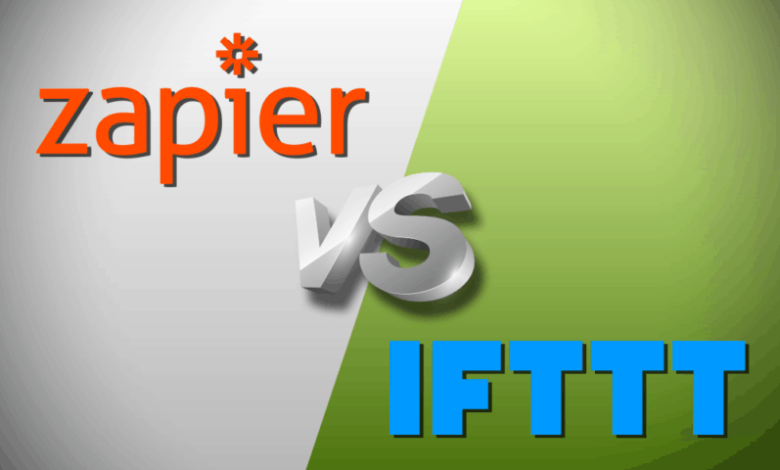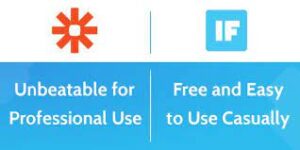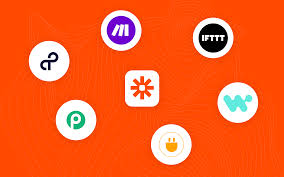Integromat vs Zapier vs Ifttt vs Flow: Which one is Best 1

Zapier and IFTTT are both powerful automation tools that enable app integration without coding knowledge. In the Zapier vs IFTTT battle, we can assist you in determining which platform is the best fit for your needs and requirements.
Key Takeaways: Zapier vs Ifttt
- Both Zapier and IFTTT are user-friendly, but IFTTT provides more guidance for users who need extra assistance, while Zapier offers a more hands-off approach.
- In general, IFTTT is well-suited for personal users, while Zapier is often preferred by companies, although this distinction is not absolute and depends on specific use cases.
- Pricing is a factor to consider. IFTTT is significantly cheaper than Zapier, but Zapier offers additional features and advantages that may make the decision less straightforward.
- Ultimately, the choice between Zapier and IFTTT depends on individual preferences, specific needs, and the purpose for which you are using the automation tools.
Zapier vs IFTTT: The Basics
Zapier and IFTTT are no-code automation tools that utilize a graphical interface for creating automated workflows.

Zapier vs Ifttt vs Flow
What is Zapier?
In the context of Zapier vs Ifttt, Zapier, established in 2011, offers advanced automation capabilities through its “zaps” concept. Zaps are multi-step workflows that connect various web applications, enabling the automation of complex tasks.
Zapier serves as a tool for automating tasks by integrating different web apps. For instance, it can automatically generate a new task in your to-do list when you receive a new email or save all Twitter mentions of your brand to a Google Sheets spreadsheet. By automating repetitive or time-consuming tasks, Zapier helps save time and streamline workflows by connecting different apps and services.
If you require sophisticated automation involving multiple apps and extended feature sets (such as cloud storage and project management), Zapier is likely the better choice, despite the associated cost.
What is IFTTT?
In the context of Zapier vs Ifttt, IFTTT, short for “If This Then That,” is a web-based service that enables users to create automated “recipes” triggered by specific events.
With IFTTT, you can automate tasks like saving Instagram photos to Dropbox or turning off lights when leaving your office. Similar to Zapier, it allows you to streamline workflows by connecting different apps and services.
IFTTT is a powerful and user-friendly platform, offering affordability compared to Zapier. However, it may have fewer business-focused app integrations. Nevertheless, it excels in social media and smart home integrations.
The strength of IFTTT lies in its intuitive interface and extensive compatibility with various apps and devices. It offers pre-built, one-step automation called applets, as well as user-created, multi-step automation called recipes. Supporting numerous services, from social media platforms to smart home devices, IFTTT caters to both beginners and tech enthusiasts. While a free plan is available, IFTTT also provides a premium subscription option for enhanced features.
IFTTT vs Zapier: Features
Both Zapier and IFTTT utilize straightforward, one-way automation to enhance workflow efficiency and reduce manual tasks. These platforms enable the automation of task creation between different tools and can establish connections between work management tools, social media platforms, and other necessary applications used in daily operations.
Mobile platform: Zapier vs Ifttt
One advantage of IFTTT is that you can create automation directly on your phone, making it convenient for on-the-go usage. In contrast, Zapier requires access through a desktop interface.
Developer tools
Both Zapier and IFTTT provide developer tools that allow users to create custom solutions. The key distinction is that Zapier’s developer tools are available for free, while IFTTT’s developer tools are only included with their highest-priced plan.
IFTTT vs Zapier: Integrations
IFTTT offers support for over 700 applets, allowing users to connect apps like Slack, Asana, Trello, and various other tools. However, there are some notable omissions, such as HubSpot and Jira.
In contrast, Zapier has a broader focus and covers a vast range of 3,000 apps. It provides extensive support for professional work tools, making it highly unlikely to encounter a tool that is not supported by Zapier’s platform.
Both Zapier and IFTTT offer users the ability to browse and search for available app integrations. They also provide a collection of pre-made templates and examples that serve as a starting point for creating custom automation. These features are valuable for scaling businesses and can be beneficial for strategic and effective marketing efforts.
Zapier vs IFTTT: Wizards for Non-Developers

Zapier vs Ifttt vs Flow
Both Zapier and IFTTT understand the importance of catering to non-developers and offer user-friendly wizards or guides to assist them in creating and managing automation.
Zapier’s “Zapier 101” guide provides step-by-step instructions for creating your first Zap, ensuring a seamless onboarding experience. Similarly, IFTTT’s “Getting started” guide walks users through the process of creating their first recipe.
These guides are valuable resources for individuals new to automation, allowing them to begin without the need for extensive technical knowledge or programming skills. Additionally, both platforms offer pre-made templates and examples that serve as a starting point for users to customize and build their automation.
Limitations and Considerations
Here are the limitations and considerations to keep in mind for IFTTT and Zapier:
IFTTT Limitations:
- Single-trigger applets: IFTTT’s applets are limited to single-trigger automation, which may restrict the complexity of workflows for users with advanced automation needs.
- Simplicity-focused: While simplicity is a strength, it can also be a limitation for users who require more intricate and advanced automation workflows.
Zapier Limitations:
- Complexity for beginners: Zapier’s extensive capabilities and features may be overwhelming for users who are new to automation or have limited technical expertise.
- Pricing based on tasks: Zapier’s pricing structure is based on the number of tasks, which may become a consideration for users with high-volume automation needs or those who anticipate scaling their automation usage.
- Overkill for basic needs: For users with basic automation requirements, the extensive features of Zapier may be unnecessary and potentially more complex than needed.
IFTTT vs Zapier: Pricing
One of the crucial factors to consider when choosing between Zapier and IFTTT is their pricing structures. Both tools offer a free plan, allowing users to test them without incurring any charges. To further evaluate their pricing models, let’s explore the details of each platform.
IFTTT Pricing
IFTTT offers three plans with varying features and limitations:
- Free Plan: This plan allows users to create up to 5 applets (individual automation) and offers standard applet speed. However, it’s important to note that the speed of each applet can vary, ranging from 15 minutes to a few hours.
- Pro Plan: For $5 per month, the Pro plan increases the applet limit to 20, enhances applet speed, enables the creation of multi-action applets, and provides access to built-in customer support.
- Pro+ Plan: Priced at $10 per month, the Pro+ plan removes applet limitations, allows the connection of multiple accounts, offers access to developer tools, and provides priority customer support in addition to the features included in the Pro plan.
These plans allow users to choose the level of functionality and support that best suits their needs and budget.
Zapier Pricing
Zapier offers a greater variety of plans compared to IFTTT, catering to a wider range of budgets. One of the key differentiators among Zapier’s plans is the number of tasks they can support per month. In Zapier’s context, “tasks” refer to individual actions performed by your Zaps.
Zapier offers a range of plans designed to accommodate various budgets:
- Free Plan: With the free plan, users can create up to five Zaps that run every 15 minutes. It supports up to 100 tasks per month.
- Starter Plan: Priced at $19.99 per month, the Starter plan allows users to build up to 20 Zaps, including multi-step Zaps. It offers features such as webhooks, and filters, and supports up to 750 tasks per month. For $39.99 per month, the task limit can be increased to 1,500.
- Professional Plan: Starting at $49 per month, the Professional plan provides unlimited Zaps and premium apps, along with the ability to build custom logic paths. Zaps update every two minutes instead of 15. It supports 2,000 tasks per month but can be scaled up to 5,000, 10,000, or even 2,000,000 tasks per month, with prices ranging from $89 to $3,389 per month.
- Team Plan: Designed for teams, the Team Plan offers unlimited users, folder permissions, and shared workspaces. Zaps update every minute. Priced at $299 per month, it supports 50,000 tasks but can be scaled up to 2,000,000 tasks per month.
- Company Plan: The Company plan includes advanced admin permissions, additional security measures, and live training with a customer success team. Starting at $599 per month, it supports 100,000 tasks per month.
These plans provide flexibility in terms of features, task limits, and pricing to cater to different user needs and business requirements.

Zapier vs Ifttt vs Flow
Integromat vs Zapier vs Ifttt
Integromat, also known as Make, offers over 1000 integrations between apps, making it a popular choice among professionals. It allows you to integrate applications with single or simultaneous actions, which can be complex due to the wide range of options available.
One notable feature is the ability to view automation reports, which helps identify failures or mistakes in the integration setup.
For programmers or those aspiring to become one, Integromat/Make provides limitless possibilities for integrating with your code.
Additionally, the free plan offers unlimited operations per month, allowing your automation to run without restrictions.
Zapier vs Flow
Zapier and Microsoft Power Automate (formerly known as Microsoft Flow) are both popular tools for automating workflows and integrating applications. Microsoft Power Automate, being part of the Microsoft ecosystem, offers advanced features and integrations with Microsoft services. It also provides capabilities like approval workflows, data manipulation, and integration with Azure services. Zapier, on the other hand, offers a simpler and more streamlined approach to automation.
Zapier vs Ifttt vs Flow:
- Microsoft Power Automate has a wide range of connectors as well, including Microsoft products like Office 365, SharePoint, and Dynamics 365.
- Microsoft Power Automate has a more comprehensive interface with a focus on advanced functionality, making it suitable for both non-technical and technical users.
- Microsoft Power Automate has different plans, including a free plan with limited functionality and paid plans based on the number of runs and premium connectors.



